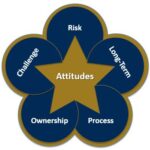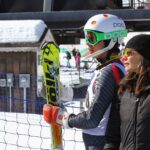Focus may be the most misunderstood mental factor among racers. Most racers think of focus as concentrating on one thing really hard for a long time. In fact, a number of years ago, former Olympic champion said that she improved her skiing by staring at her skis for ten minutes a day. She may have believed that, but, given the complexity of ski racing, it probably didn’t help much.
Let me introduce a term and then I’ll define focus for you. Attentional field is everything inside of you, such as thoughts, emotions, and physical responses, and everything outside of you, including sights and sounds, on which you could focus. Focus is the ability to concentrate on things in your attentional field that will help you ski well and avoid distractions in your attentional field that will prevent you from skiing well.
Think of all the things that you need to focus on before a race: course inspection, skiing warm-up, your start-area routine. And what about everything you need to focus on during a race, for example, the course, the terrain, the snow conditions, your line, and your speed.
Now think of all the things that can distract you during a race. These distractions fall into two categories. Interfering distractions involve things that directly hurt your skiing, for example, seeing and hearing your coaches or parents on the side of the course, thinking about a mistake you just made, or worrying about results. Irrelevant distractions simply distract you from an effective focus, for instance, what you’ll have for dinner, thinking about your friends, or the homework you haven’t finished yet.
Your goal is to always maintain prime focus, that is, focus on things that will help you ski your fastest and avoid distractions that hurt your skiing.
Focus Style
One of the most important developments I’ve made in my work in recent years is in understanding the importance of identifying racers’ focus styles. A focus style is a preference for paying attention to certain things. Racers tend to be more comfortable focusing on some things and avoid or don’t pay attention to other things. Every racer has a dominant focus style that impacts all aspects of their ski racing. This dominant style will surface most noticeably when you’re under pressure. The two types of focus styles are internal and external.
Internal focus style. Racers with an internal focus style ski best when they’re totally and consistently focused on their ski racing during training or their pre-race preparations. They need to keep their focus narrow, thinking only about their ski racing. These racers tend to be easily distracted by activity in their immediate surroundings, such as other racers, coaches, and course reports. If they broaden their focus and take their mind off their ski racing, they’ll become distracted and will have trouble narrowing their focus back onto their ski racing. Lindsey Vonn and Benni Reich are examples of World Cuppers with an internal focus style.
External focus style. Racers with an external focus style perform best when they only focus on their ski racing when they’re about to begin a training or race run. At all other times, it is best for them to broaden their focus and take their mind off their ski racing. These racers have a tendency to think too much, become negative and critical, and experience competitive anxiety. For these racers, it’s essential that they take their focus away from their ski racing when they’re not actually skiing. These are the racers you’ll find at the top of a training course or in the start area of a race chatting it up with friends. Of course, shortly before they get into the starting gate, they do need to narrow their focus onto the race. Julia Mancuso and Manfred Pranger are two examples of World Cuppers with an external focus style.
External focus style runs counter to beliefs held by many ski coaches. They think that if racers aren’t totally focused on their ski racing all of the time, then they’re not serious won’t ski their best. Yet, for racers with an external focus style, they don’t want to think too much or be too serious because this causes them to lose confidence and become anxious. They’ll ski their best when they’re not thinking too much about their ski racing and they simply allow their natural abilities to emerge on their own (think Bode Miller).
Identifying Your Focus Style
With this understanding, you need to identify your focus style. Are you an racer who needs to keep your mind on your ski racing constantly for you to ski your best? Or are you someone who thinks too much and needs to keep your mind off your ski racing until its time to get in the gate? Here’s how to figure it out.
Recall past races when you’ve skied well. Were you totally focused on your ski racing or were you keeping your mind off it? Also, recall past races when you’ve skied poorly. Were you thinking too much or were you distracted by things going on around you? If you’re like most racers, a pattern will emerge in which you tend to ski best when you focus one way and you ski poorly when you focus another way.
Understanding your focus style is essential for you to be able to manage it effectively. This process involves knowing how you focus best and actively focusing in a way that is consistent with your focus style. This ability to manage your focus style well is most important in pressure race situations. There is a tendency for racers under pressure to revert back to a focus style that will interfere rather than help their skiing. For example, if you’re someone who skis best with an external focus style, you may find yourself turning your focus inward when the pressure is on. You may start to think too much and become anxious.
When you start to lose your prime focus style under pressure, you must become aware that you’re moving away from it and that you need to take steps to redirect your focus back to the style that works best for you. Continuing the previous example, when you realize that you’re focusing internally too much, you should actively turn your focus outward by looking around, talking to others, and taking your mind off your ski racing.
Mag-Lite® Focus
I’ve developed a useful tool to help you understand your focus style and to develop focus control. A Mag-Lite® is a flashlight whose beam can be adjusted to illuminate a wide area or to brighten a narrow area. Your focus can be thought of as a Mag-Lite® beam you project that illuminates what you want to focus on.
If you have an internal focus style, your goal is to stay focused on necessary training or race cues and to block out unnecessary external distractions. To accomplish this, narrow your Mag-Lite® beam by avoiding talking to others at the top of training courses or doing your pre-race routine away from the activity of the start area. Focus on what will enable you to ski your best, for example, the proper technique for your next training run or your physical warm-up in the start area before your race run.
If you have an external focus style, your goal is to direct your focus off of your ski racing before training and race runs. To do this, when you’re not actually skiing, whether in training or a race, widen your Mag-Lite® beam by looking around and talking to your coach or other racers. This will keep you from thinking too much and becoming anxious. Shortly before you begin your training or race run, narrow your Mag-Lite® beam and focus specifically on something that will help you ski your best.
Your goal, as noted in the title of this post, is that you have total focus and no distractions from the moment when you kick the starting wand to when you trigger the finish beam.






